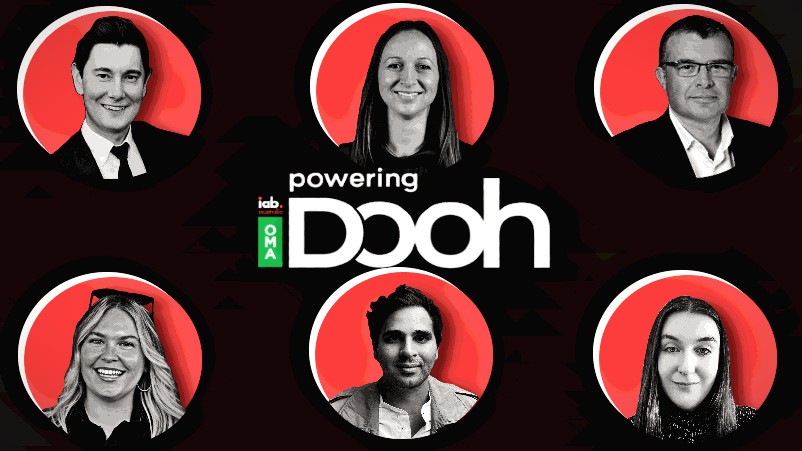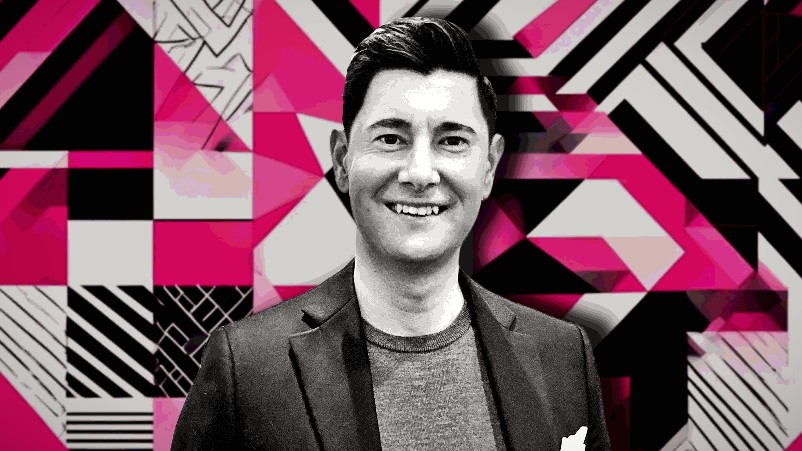Scaling programmatic DOOH: Agencies say they have de-siloed, now media owners must do likewise if they want to move growth needle

Kinesso's Michael Whiteside, PHD's Joanna Barnes, VIOOH's Jean-Christophe Conti, EssenceMediacom’s Katherine Pochroj, Nexus' James Lambert, and Initiative's Paige Wheaton
Programmatic digital out of home (pDOOH) is starting to make headway in the Australian marketplace, but remains a single digit percentage of the overall OOH pie. To start catching up with penetration in more advanced markets, agencies reckon owners must fully embrace the medium and stop selling – and setting targets – in silos. In return, they will do their bit on justifying higher CPMs. Nexus’ James Lambert, PHD’s Joanna Barnes, Initiative's Paige Wheaton, Kinesso's Michael Whiteside, EssenceMediacom’s Katherine Pochroj and Jean-Christophe Conti weigh in.
What you need to know:
- 37 per cent of media plans created by Australian advertisers in the last 18 months have included programmatic digital out of home (pDOOH), and that’s expected to rise in 2024, according to research from digital out of home marketplace, VIOOH.
- One third of advertising executives plan to shift budget into pDOOH this year, with 15 per cent per cent of investment expected to be incremental – new rather than lifted from other channels.
- But uptake is still limited by siloing between digital and traditional buying teams, VIOOH CEO Jean-Christophe Conti told the IAB and OMA’s Power Digital Out of Home conference, hence “the numbers are not yet at the level where they should be”.
- Initiative’s Chief Investment Officer, Paige Wheaton, said that programmatic specialists can no longer be siloed from traditional agency teams. She’s calling for the “programmatic” terminology to be dropped completely because it's outdated. “In terms of how we buy, everything is omnichannel. I don't even really love talking about convergence anymore. Programmatic outdoors to me is just outdoor.”
- Others media buyers agree: GroupM’s Nexus is now "digital out of home-first", per head of advanced out of home, per James Lambert, while PHD likewise started heading that way six years ago, said National Head of Investment, Joanna Barnes.
- But Barnes thinks outdoor media owners must now step up on convergence, particularly within their sales teams.
- While silos are part of the problem, Kinesso Chief Media Activation Officer Michael Whiteside suggested pDOOH growth has been crimped by high CPMs, with price the “arbitrator” of investment in the absence of sufficient measurement – though he thinks that will change with MOVE 2.0.
- EssenceMediacom Group Marketplace Director, Katherine Pochroj, said higher prices can be justified if targeting, data and flexibility beget better results – otherwise "it's like comparing apples and cheese" – but agencies need to do a better job of explaining them
You still have agencies where all the [pDOOH] decisions are not centralised within one team ... and this is why I think the numbers are not yet at the level where they should be.
According to research from digital out of home marketplace VIOOH, Australian advertisers have included pDOOH in 37 per cent of media plans over the last 18 months – five points ahead of global averages.
The platform’s CEO Jean-Christophe Conti travelled to Sydney this month to present the findings of the State of the Nation report for digital out of home at the Powering Digital Out of Home summit – a joint venture between IAB Australia and Outdoor Media Alliance (OMA), the two aligning more closely as OOH digitises.
Conti is enthusiastic about the potential for further programmatic growth – and appears to have good reason as the broader OOH sector appears to be hoovering up at least some of the leakage from media like TV.
“One third of execs – so the ones who actually spending money within media agencies or brands – are actually saying that they're going to be incrementally moving their budget to spend more in programmatic out of home in 2024,” per Conti.
VIOOH’s research suggests that 29 per cent of pDOOH budgets being allocated locally will come from other digital channels, while 28 per cent will be taken from traditional channels, and another 15 per cent will come from newly allocated budgets.
The latter figure puts Australia alongside its US and UK counterparts (both 15 per cent), and behind only France (16 per cent) in terms of new money. By comparison, Spain and Germany saw only 9 per cent of pDOOH budgets newly allocated, and the global average is 13 per cent (though Germany is far more mature in its programmatic transition, with circa 25 per cent of OOH already traded programmatically back in 2020.)
While new money is a positive growth signal, Conti said the rollout of these budgets is inconsistent across the industry, pointing to ongoing issues with siloing. Dedicated pDOOH teams are most likely to access new pDOOH budgets (22 per cent), followed by digital/programmatic teams, with the main OOH team faring the worst (7 per cent).
“You still have agencies where all the [pDOOH] decisions are not centralised within one team,” per Conti, “and this is why I think the numbers are not yet at the level where they should be.”
In terms of how we buy, everything is omnichannel. I don't even really love talking about convergence anymore. Programmatic outdoor to me is just outdoor.
Media buyers: converged
Siloing within out of home is not a new issue – and similar issues have been long debated in other areas such as TV buying.
Speaking across panel sessions throughout the course of the Powering DOOH event, agency executives doubled down on the need for convergence.
Initiative’s Chief Investment Officer, Paige Wheaton, said programmatic or performance specialists can no longer be siloed from traditional agency teams – “that can’t exist anymore”.
The convergence of programmatic and traditional OOH, said Wheaton, has been critical from a “connectivity perspective”, showcasing “the need for us to be holistic working together as one team”.
She thinks it’s time to do away with the “programmatic” moniker – “I think the time has come where we don't need to keep putting kind of a buy type in front of it.”
“In terms of how we buy, everything is omnichannel. I don't even really love talking about convergence anymore. Programmatic outdoor to me is just outdoor," she said.
“It's time that we, as a group, come together to really normalise that it's just outdoor, and that [programmatic] is just a tactic of trading within outdoor – and that it should live within all campaigns for all clients where feasible."
James Lambert, Head of Advanced DOOH at GroupM’s performance marketing arm, Nexus, seconded Wheaton’s calls.
Formerly colleagues during Wheaton’s time at GroupM agency Mindshare, the pair worked closely to break down silos between programmatic and traditional OOH buys.
Lambert says Nexus now positions its out-of-home capabilities as a “digital out of home-first proposition” powered by “programmatic technology, data and tech”.
Per Lambert: “We don’t say programmatic, we say digital out of home or advanced digital out of home."
PHD has likewise shifted to an omnichannel approach – starting six years ago when TV and audio dollars began to move into their digital variants, said National Head of Investment, Joanna Barnes: “We knew that it was coming”.
PHD then had senior traders certified by The Trade Desk, which “allowed them to talk the same language as any platform specialist”, she said, while traders who were programmatic specialists then became activation specialists, delivering at the business end.
Planners, she said, remain agnostic.
“From a planning perspective, the planner plans [the campaign] end-to-end, regardless of channel,” according to Barnes. “We don't have a digital planner on out of home – it's just one planner across a whole ecosystem.”
While the same buying and measurement debates are being had, Kinesso Chief Media Activation Officer, Michael Whiteside, said there is nuance to navigate.
“We take convergence very seriously in the out-of-home space,” he said. “I think it's very different to convergence from a video and audio standpoint – [OOH] assets are consumed very differently to the likes of TV and radio.”
He said Kinesso and the broader IPG group have facilitated a shift from the “tactical application” of pDOOH to “more always on strategic performance”.
OOH owners turn
With convergence seemingly done on the agency side, PHD's Barnes suggested OOH owners sales teams are actually the laggards.
“I had a salesperson that I spoke to last year... and they said that they’re not meeting their targets because [spend] was all moving to programmatic.
“I said: ‘Well, you need to either adjust your targets – because it is going that way. Or just converge and bring it within the one target'.”
Obviously, I'm not encouraging anyone to put up prices - I'd love them to go down. But I think that the onus is on us.
Pricing issues
While convergence has significantly moved the dial forward on the uptake of pDOOH, without sufficient ability to measure and compare static versus programmatic executions, the higher costs associated with the channel can become barrier to entry,
Whiteside says that until MOVE 2.0 – the OMA’s much anticipated upgrade to its 14-year-old OOH measurement solution – launches this year, “price parity” stands in as the “the arbitrator of where the investment goes”.
“So, because programmatic CPMs [cost per mille] at the moment are a lot higher because of the targeting selectivity that's applied, that's one of the main inhibitors to accelerated adoption.”
EssenceMediacom’s Group Marketplace Director, Katherine Pochroj, agreed, but said agencies should be educating clients on why they are paying more for better targeting, data and greater flexibility.
“We've done a lot of work in terms of [establishing] the differences in the CPMs and what a strike rate can look like for programmatic out of home, because we know that the audience that we're going after it is not your generic demographic – we are being more targeted, and we want to be.
“All these case studies are showing that when you are more targeted, the results are better. So, the CPMs are not the same – it's like comparing apples and cheese.” she said.
“Obviously, I'm not encouraging anyone to put up prices – I'd love them to go down. But I think that the onus is on us,”
Pochroj's sentiments reflect Conti’s concluding presentation points, where he doubled down on pDOOH’s higher return on investment.
“The price is not really the point … if it's efficient, and if obviously, it has a greater impact brand and performance, prices are going to go up. How can they be sustained? Because it's about return on investment."
Over to procurement...


